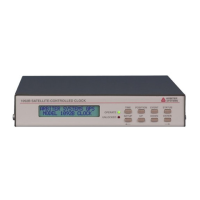3.5 Connecting Output Signals 13
3.5 Connecting Output Signals
Output signals may be connected through designated standard or option connector. For standard
I/O connectors, see Section 2.3.6. Terminals are Phoenix-type with 5-mm spacing and will accept
between 0.25 and 2.5–mm wire diameter. For Options that have terminals for output connectors,
see Appendix C for details about those options and connectors. BNC connectors (on installed
option boards) are female and require only connecting the (male) connector into it.
To connect wires to any of the terminals, strip the insulation back to expose about 1/4” of bare
wire and DO NOT tin the bare end. Insert the stripped wire into the terminal and turn the screw
down to secure it in the connector.
3.6 Connecting Input Signals
Input signals may be connected through the designated I/O terminals, the RS-232 connector and
through an installed option connector designated as Input. For standard I/O connectors, see
Section 2.3.6. Terminals are Phoenix-type with 5-mm spacing and will accept between 0.25 and
2.5–mm wire diameter. Option 95 has four BNC connectors and allows connection of an input signal
for event timing besides the three output connectors. See specific option number in Appendix C
for details about wiring and connectors. BNC connectors (on installed option boards) are female
and require only connecting the (male) connector to it.
To connect wires to any of the terminals, strip the insulation back to expose about 1/4–inch of
bare wire and DO NOT tin the bare end. Insert the stripped wire into the terminal and turn the
screw down to secure it in the connector.

